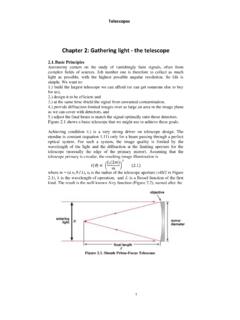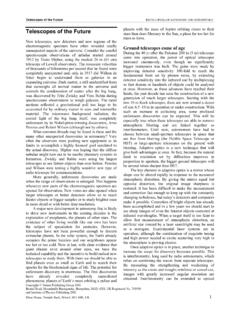Transcription of Basic Functions of Telescopes - College of Charleston
1 1 Lec 7: 31 JAN 2012 ASTR 130 - Introductory Astronomy II (Chapter 6) LAST TIME - Finish and Review Chapter 5 Doppler Effect Exercise: Limitations of Ground-Based Observing TODAY- Observatories and Instruments Basic Functions of a telescope Design and Construction of Telescopes Limitations of Telescopes and the Atmosphere How We Overcome Limitations THURSDAY - Finish Chap. 6 & Review Chap. 16 Observatories, Instruments, and Detectors Observing from the Ground and Space Properties and Structure of the Sun Telescopes 1. What IS a telescope ? (and what isn t) 2. What are its Functions ? 3. How are they DESIGNED? 4. What are their LIMITATIONS? 5. How can we overcome these limitations? 6. Telescopes for all types of EMR. What is a telescope ? A telescope is a device that: Collects light that falls over a large area Concentrates ( focuses ) this light into an image Image preserves information about object, but it is brighter and clearer than object appears otherwise Image is then passed through an instrument ( a spectroscope) and recorded for further analysis Its principal function is to gather a lot of light!
2 Eye telescope Basic Functions of Telescopes 1. Light Gathering Power proportional to AREA of main mirror or lens aperture (diameter of main mirror or lens) is the most important design criterion makes a FAINT object appear BRIGHTER 2. Magnification make small object appear larger (this is not nearly as important in astronomy) depends on eyepiece, not aperture ( 25mm ~ 80x; 40 mm ~50x greater magnification also causes distortions, vibrations, etc. to be worse even a small telescope can magnify a lot, but image will not be clear Aperture Light gathering power AREA of collecting surface Area = R2 Aperture = diameter of lens or mirror R R2 eye cm cm2 binocculars 5 cm 25 cm2 lab scopes 8 ~ 20 cm 400 cm2 scientific scope m x 104 cm2 biggest scopes 10 m 106 cm2 RBasic Functions of Telescopes 1. Light Gathering Power 2. Magnification make small object appear larger (this is not nearly as important in astronomy) depends mostly on eyepiece, not aperture ( 25mm ~ 80x; 40 mm ~50x) [even a small telescope can magnify a lot, but image will not be clear] greater magnification also causes distortions, vibrations, etc.)
3 To be worse 2 Basic Functions of Telescopes 3. Resolution ability to distinguish things that appear very close together higher resolution --> smaller angle --> sharper images = s/d (radians) = s/d (degrees) Angular Resolution: = /D (radians) Larger aperture --> better angular resolution (smaller angle is better) BUT, our atmosphere severely limits resolution! d s s d Two Basic Types of telescope Design REFRACTING use lenses to bend light REFLECTING use mirrors to bend light convex lens concave mirror Refraction flat surface bends but exit parallel to input double convex surface bends and bends again to bring light to focus Reflection angle of incidence = angle of reflection curve surface into the shape of a parabola and parallel rays focused to a point A Refracting telescope Eyepiece magnifies the real image formed by objective lens in the focal plane, so it is located behind the focal plane. We could put a detector at the focal plane instead (you might call this a camera instead of a telescope ).
4 Shape of mirror s surface must be parabolic or light won t all focus at a point. But there are spherical and elliptical reflectors for special uses. Image formed on same side as the light comes in! Se we need a different can t put eyepiece here! a second mirror must be used (several ways to do this) A Reflecting telescope 3 Some problems with Lenses: big, heavy, expensive 2 surfaces to curve must be transparent and flawless hard to mount chromatic Reflectors are more common than refractors larger apertures possible don t lose light transmitting through glass much cheaper for the same light gathering power Which is Better? Aberrations Chromatic Aberration focal length depends on color to fix: multiple lenses; coatings mirrors don t have this problem, but they do have Spherical Aberration that s why we make mirrors parabolic in shape Some problems with Lenses: big, heavy, expensive 2 surfaces to curve must be transparent and flawless hard to mount chromatic Reflectors are more common than refractors larger apertures possible don t lose light transmitting through glass much cheaper for the same light gathering power Which is Better?
5 Seeing Through the Atmosphere Reflection some of starlight reflected back to space some artificial light reflected back down ( light pollution ) Absorption UV, X-ray, -ray completely absorbed IR mostly blocked water vapor and oxygen absorption lines Emission sky glow aurorae Transmission close to 100% for visible and radio, but .. haze, dust, water vapor, etc. decrease this seeing : blurring, twinkling, distortion WEATHER!!









